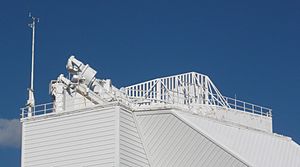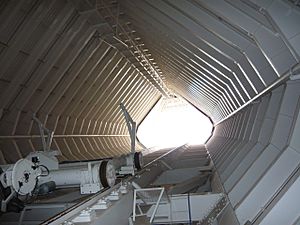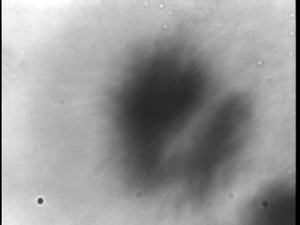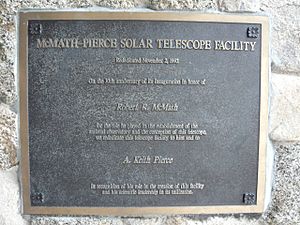McMath–Pierce solar telescope facts for kids
 |
|
| Alternative names | McMath–Pierce Telescope |
|---|---|
| Named after | Keith Pierce, Robert Raynolds McMath |
| Part of | Kitt Peak National Observatory |
| Location(s) | Arizona |
| Coordinates | 31°57′30″N 111°35′42″W / 31.9584°N 111.595°W |
| Organization | NOIRLab |
| Altitude | 2,096 m (6,877 ft) |
| Observing time | 79 percent |
| First light | 1962 |
| Telescope style | reflecting telescope solar telescope |
| Number of telescopes | 3 |
| Diameter | 161 cm (5 ft 3 in) |
| Angular resolution | 0.07 arcsecond |
| Collecting area | 2.04 m2 (22.0 sq ft) |
| Focal length | 87 m (285 ft 5 in) |
| Mounting | equatorial mount |
| Website | noirlab |
The McMath–Pierce Solar Telescope is a very large telescope in Arizona, United States. It is part of the Kitt Peak National Observatory. This special telescope is designed to study our closest star, the Sun.
It was built in 1962 and was once the biggest solar telescope in the world. It was also the largest optical telescope that had a clear view without anything blocking its main lens. The telescope is named after two famous astronomers, Robert Raynolds McMath and Keith Pierce.
The building itself was designed by architect Myron Goldsmith and engineer Fazlur Rahman Khan. It was first called the McMath Solar Telescope. Later, in 1992, it was renamed the McMath-Pierce Solar Telescope. Even though it's made for the Sun, it can also look at bright objects in the night sky. In 2018, it received a big grant to improve its visitor center and other programs. This helps keep this important national landmark going strong.
Contents
How the Solar Telescope Works
The McMath–Pierce Solar Telescope is actually three telescopes in one! It has a main telescope and two smaller ones. These are called the "East" and "West" auxiliary telescopes.
Catching Sunlight with Heliostats
At the very top of the main tower, there's a special mirror called a heliostat. This heliostat acts like a giant sun-catcher. It moves to follow the Sun across the sky. This way, it can always direct the Sun's light down a long, slanted tunnel.
The tunnel goes deep underground. This is where the telescope's main mirror is located. The long path helps keep the light stable and clear.
Seeing the Sun Clearly
The main telescope can theoretically see very fine details on the Sun. However, Earth's atmosphere can make images blurry. To fix this, scientists added an adaptive optics system in 2002. This system helps to correct the blurriness caused by the air. It makes the images of the Sun much clearer and sharper.
The Auxiliary Telescopes
The two smaller telescopes, East and West, work separately from the main one. They each have their own heliostat. These auxiliary telescopes are also used to study the Sun.
Tools for Studying the Sun
The main telescope has a third mirror that sends the sunlight into a special observing room. This mirror can move to different spots.
Using Spectrographs
Under two of these spots are vacuum spectrographs. A spectrograph is a tool that breaks light into its different colors. This helps scientists learn what the Sun is made of and how it moves. One spectrograph is very deep, about 18 meters. The other is shallower, about 4 meters deep. These spectrographs can even rotate to keep the image of the Sun steady.
The auxiliary telescopes also have tools for studying light. However, they don't have the same image rotation correction as the main telescope.
Future of the Telescope
In 2016, the National Science Foundation (NSF) planned to stop funding the McMath–Pierce Solar Telescope. But people wanted to keep this important telescope running.
In 2018, a new plan was proposed. The NSF then gave a grant to the Association of Universities for Research in Astronomy. This organization helps run the Kitt Peak National Observatory. The grant will help keep the telescope active and improve its facilities for visitors.
See also
- List of solar telescopes
- Lists of telescopes
- List of largest optical reflecting telescopes
- Daniel K. Inouye Solar Telescope
Images for kids







